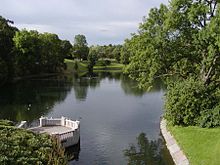Frogner Park
The Frognerpark ( Norwegian Frognerparken ) is a public park in Oslo . It is part of the Frogner estate ; the district of Frogner was named after the estate. The park contains the Vigeland sculpture complex with numerous granite sculptures by the Norwegian sculptor Gustav Vigeland . Most of the sculptures were created between 1926 and 1942.
location
The Frognerpark is located in the area of the old Frogner farm (Norw. Frogner Hovedgård ). The 18th century courtyard development is located in the western part of the park, where the Oslo Bymuseum (city museum) is located, which moved here in 1909. In the park are also the Frogner-Bad ( Frognerbadet ) from 1954, the Frogner Stadium and tennis courts.
history
The Frognerpark goes back to Gut Frogner, which was already known in the early modern era. It was bought in 1790 by Bernt Anker , a chamberlain and at the time the richest man in Norway, and expanded to about 300 hectares. At that time it was already one of the largest parks in the country. In 1836 the estate was acquired by Benjamin Wegner , an industrialist and Hanseatic consul general. He redesigned the park as a romantic landscape park. The city of Christiania bought the Frogner estate with the Frogner Park in 1896 for around 700,000 crowns and opened the park in 1904 as a public park.
flora
The park houses Norway's largest collection of roses with around 150 species. The abundance of trees is also significant; there are walnut trees as well as magnolias and linden trees .
Web links
- Website Frognerparkfreunde (Norwegian)
- Website of the municipality of Oslo on Frognerpark (Norwegian)
- MegaHoliday.com (pictures)
Coordinates: 59 ° 55 ′ 37 " N , 10 ° 42 ′ 4" E

